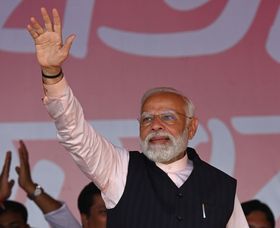Ten years ago, a resounding electoral mandate ushered in the BJP government under the leadership of Prime Minister Narendra Modi. The slogan that swept the nation then—Vikas Bhi, Virasat Bhi (development as well as heritage)—resonated deeply. While forging ahead, the Union government has not forgotten its commitment to heritage and culture.
It has celebrated the culture and heritage of the northeast like never before. For decades, the northeast remained geographically and economically distant. Today, significant investments in road and air connectivity, coupled with various initiatives and development projects, are bridging the gap. Tourism infrastructure is booming, showcasing the region’s unique culture and natural beauty. This focus has led to a surge in economic activity and improved the living standards.
India’s road infrastructure has already seen a remarkable transformation. As of July 2023, over 60,000km of national highways have been constructed or widened, a significant increase from 34,339km in 2014. While the Indian Railways has witnessed modernisation with initiatives like the Vande Bharat trains and dedicated freight corridors, it also offers comprehensive Ramayana-based tour programmes, and a Buddhist circuit train. A Sufi-circuit is also in the pipeline.
India has emerged as a global leader in digital adoption with UPI, digitisation of data in the government sector, introduction of GeM (Government e-Marketplace) portal and digitisation of museums and libraries, while preserving what has been our cultural heritage for thousands of years. Startup India, with over 81,000 recognised startups, fosters innovation and entrepreneurship.
What’s more, the National Education Policy (NEP) emphasises the inclusion of regional languages, fostering cultural identity and inclusivity. This move resonates with India’s multilingual reality, strengthening connections to the past and present.
The Modi government has recovered artefacts stolen from India, like the idol of Goddess Annapurna. The Metropolitan Museum of Art, New York, returned 15 artefacts in 2021 and more than 300 from 2014 to this day, which includes a ceramic pot from Chandraketugarh era, which belongs to the first century BCE, a stone bust of Kamadeva, the god of love, from the second half of the eighth century CE, a Svetambara enthroned Jina, with attendant Yaksha and Yakshi (11th century CE).
While India’s global presence was elevated at the G20 through our modern approach and infrastructure, the G20 theme, ‘Vasudhaiva Kutumbakam’ (the world is one family) highlighted India’s cultural heritage as a guiding principle for global cooperation.
While India showcased technological prowess through locally developed Covid vaccines that were transported to 101 countries, we also organised the ‘Festival of India’ initiative, showcasing our diverse cultural experiences at embassies worldwide, fostering appreciation on the global stage.
Schemes like Karmyogi, Vishwakarma, and SVANidhi have empowered skill development and transformed lives across sectors. It is a matter of joy that UNESCO, in the recent times, has also included the Ramappa Temple, the Hoysala temples, Dholavira, Santiniketan, Durga Puja, Garba and Kumbh Mela as intangible cultural heritage of the world.
The BJP government’s 10 years have been marked by a conscious effort to balance development with the preservation of heritage. While strides have been made in infrastructure, digitisation, and regional development, the journey is ongoing. Yet, the emphasis on preserving and celebrating India’s rich cultural legacy sets a unique tone for the nation’s future. As India continues to grow and evolve, it does so by drawing inspiration from its past while confidently striding towards a brighter tomorrow.
Lekhi is Union minister of state for external affairs and culture.


